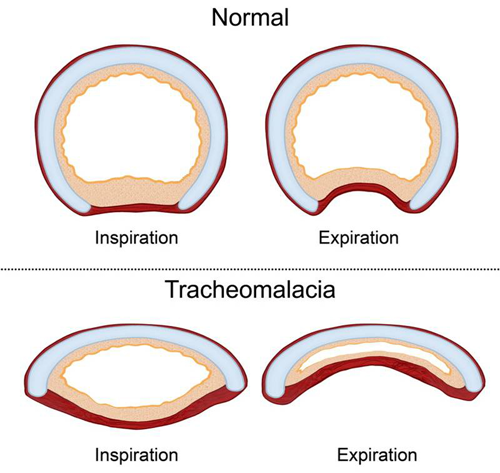Tracheomalacia / Bronchomalacia information
The trachea extends from the larynx above until the beginning of the bronchi. The trachea and bronchi can be considered to a tree with further ramifications of the bronchi into the lungs. There are 2 main bronchi - each for the right and left lung, which in turn divide into several segmentary bronchi.
The trachea and bronchi are made of incomplete rings of cartilage, which maintains their architecture and stability during respiration. Tracheomalacia and/or bronchomalacia are conditions in which the airways are collapsible and do not allow sufficient oxygenation of the lungs.
Causes
There are 2 possible causes:
- Congenital - when present at birth and may be associated with other conditions. Certain malformations of the heart and large vessels in the chest can cause extrinsic pressure on the trachea and bronchi thus further softening the cartilage and causing it to collapse.
It could be associated with other congenital anomalies of the trachea (laryngotracheal clefts, tracheal stenosis) and esophagus (esophageal atresia, tracheoesophageal fistula).
- Acquired - could be secondary to trauma or tracheostomy which induces weakening of the cartilages.

Signs and symptoms
Tracheo / bronchomalacia affects the expiratory phase of respiration. The patient has noisy breathing (wheezing), breathelessness on effort and easy fatiguebility on increased activity. A baby may also suffer from blue episodes (cyanosis). There is stagnation of secretions in the lungs predisposing to repeated attacks of pneumonia.
Diagnosis
It is clinical interpretation combined with endoscopy that gives us the diagnosis. Confirmation is done by performing transnasal flexible laryngobronchoscopy, which involves looking into the windpipe using a telescope attached to a camera.
Treatment
Treatment of tracheo / bronchomalacia depends largely on its severity, exact location, cause and the endoscopic picture.
Its treatment can take several months and is one of the most difficult chronically affecting conditions of the entire airway. The condition can affect the proximal (upper) or distal (lower) trachea with or without bronchial involvement. Long distal tracheobronchomalacia is more troublesome to treat.
Mild cases will improve with time. If the cause is due to compression of the trachea by a large vessel or mass in the chest, then the surgeons will discuss an operation. In case there is no such extrinsic cause, the treatment will be by a mask and positive airway ventilation or CPAP. Using the mask, air is forced into the collapsed airway to oxygenate the lungs. The time period for which this is required is variable and patient dependant.
Tracheostomy-induced weakening is best treated by surgery (tracheal resection and anastomosis).
For patients staying outside Switzerland, a systematic plan of follow up is prepared taking into consideration the long distance of travel and individual country insurance policies.



